Old Humboldt County Court House, between 4th & 5th and I & H Streets. All photos via the Humboldt Historian.
My one claim to fame growing up in Eureka was the title of Humboldt County’s Miss Dog Tag. Other girls, dressed in one-piece swim suits and high heels, told of their dreams of a better world as they competed for the title of Miss Humboldt County, a preliminary to the Miss California Contest, which could even lead to the National Miss America Pageant with Bert Parks as master of ceremonies.
But not I.
For three summers, from 1951 through 1953, my title was Miss Dog Tag of Humboldt County. How did I come to claim such a title?
In 1951, after four years of marriage, I was divorced and on my own. To my relief, my mother insisted I move in with her. We agreed that I would pay her fifty dollars a month for room and board. I was earning $300 a month in my new position teaching upper grades at Rolph Elementary School in Fairhaven. Since I had more college credits than the primary grade teacher, I was paid an additional five dollars a month to be principal of the school. This job involved making out attendance records for the county each month, ordering school supplies, putting them away in the school storeroom, and taking inventory of supplies at the beginning and end of each school year. I loved my teaching position at Rolph School and felt that it was my school. Janice Lansing taught the primary grades the first year I was there, Winnie Hill the next, and Glenna Davis the following two years.
Although there was a workmen’s ferry from the docks in Eureka to Mutual Plywood, a mill adjacent to the Rolph School, there was no bridge across the bay from Eureka to Samoa and Fairhaven in the 1950s. I had to drive all the way around the bay to get to school. World War II had not been over long in 1951. Factories were still gearing up to civilian needs. I worried that any car that had survived four years of wartime use, plus nearly six years post-war use, would not be reliable, so I put a down payment on a new 1951 baby blue Ford sedan. My car payments were $90 a month. At that time, beginning teachers in Humboldt County schools were paid only for the months that school was in session. This left me with no income for the three summer months.
Naida’s new baby blue Ford.
I doubled the car payments so I would not lose my car during the summer. By the time I made double car payments, paid my mother for room and board, bought gas that ran $20 a month, paid my dentist $10 a month, and shopped for necessary things like shampoo, I had five dollars a month left to do with as I pleased. Even if I saved every spare dollar, it would not be enough to tide me over the summer. I needed a summer job.
An opportunity for temporary work turned up in the County Clerk’s office at the court house. Fred J. Moore, Jr., the County Clerk, offered to stop by my mother’s house at 1521 Sixth Street in Eureka, and interview me. Fred was a brother of Franny Moore, tbe football coach at Arcata High School, and also a brother of Herb Moore, an Arcata physician who, during one rainy winter while I attended Humboldt State College, had removed my infected tonsils for a fee of fifty dollars. Fred Moore was a medium-sized man with sandy- colored hair. He sat on my mother’s flowered chintz-covered sofa while she served coftee in her best Haviland china cups. After chatting awhile. Fred J. Moore offered me the job of selling dog licenses during the summer at the legal minimum wage of fifty cents an hour.
The old courthouse took up one city block and stood like a wedding cake frosted in pale yellow butter-cream icing, surrounded by lawns, shrubs, trees, and paths. Broad staircases rose from Fourth and Fifth Streets to the second fioor, where the county offices were located. The old courthouse looked to me like a courthouse should look, with a clock tower that served as a landmark, even if it did not always tell the correct time.
Each morning, I climbed the broad Fifth Street staircase of the old courthouse. Tall, double doors opened into a high-ceilinged hallway. The County Clerk’s office was the ñrst one on the left and took up one quarter of the second floor. The tall door to this office was wrapped with grooved, milled, straight-vertical-grain redwood molding, stained and varnished dark hrown, as were all the other windows and doors in the court house. Emma Cox Alcala was the County Recorder, with an office across the hall on the east side of the building. Judges’ chambers, courtrooms and court reporter offices were on the third floor.
Inside the County Clerk’s office, a forty-inch-high railing ran from the door to the counter, a distance of about ten feet, with a small gate near the counter. My little desk stood just in front of this gate inside the railing. A small sign sitting on top of the railing to one side of my desk announced “DOG LICENSES.” On the back of this sign, someone had written my name and “Miss Dog Tag 1951.” I sat at my desk facing the door, and the first things people saw when they walked into the County Clerk’s offices were the dog license sign and my smile.
Filing cabinets reached from floor to ceiling on the west wall between the tall windows of the County Clerk’s office. Clerks had to use a ladder that ran along a railing to reach the higher file drawers. Heavy wooden desks stood behind the counter the length of the room. Fred’s desk was centered between the windows. situated so that he could see everyone who came in or out of the office, but he rarely sat still at this desk. He was always busy.
Gigantic legal ledgers, so huge I don’t know if I could have picked them up, were stored under the counter. Beulah Wahlund, who became my good friend while I worked there, is a petite person, but she was able to handle these mighty ledgers, in which the entries were hand-written, and to help people with legal matters. Beulah said the heavy ledgers stored under the counter on rollers instead of shelves, which made it easier to slide them in and out out.
Women of the Courthouse, County Clerk’s Office, from lefi: Beulah Wahlund, Helen Tierney, Dorothea Martell, and Rose Vossberg.
Others in the County Clerk’s Office at that time were Merlyn Allen, Barbara Anderson, Helen Tierney, Rose Vossberg and Elizabeth Griffin. Sam Glenn and Dorothea Martell were courtroom clerks who spent some of their time in the County Clerk’s office and the rest of their time in the courtrooms. Court was very formal in those days, and Sam and Dorothea always wore suits when they had to appear in court, although Dorothea might take her jacket off when she came back into the County Clerk’s office.
Two judges sat in the Humboldt County Court House during this period: Delos A. Mace and Carl L. Christiansen, Jr. There were only two female attorneys in Humboldt County then: Grace Dempster in Fortuna and Elizabeth Morrison in Eureka. A very colorful attorney, Blaine McGowan, wore western suits, cowboy boots and a Stetson hat; but ofcourse he did not wear the hat in court. Former Senator Irwin T. Quinn, Collis Mahon (Fortuna), George Corbett, Chester Monette, Jeremiah R. Scott, Sr., Arthur W Hill. rested Francis B. Mathews, and many others were attorneys in the 1950s. Beulah Wahlund remembers Jeremiah Scott, Sr. as a wonderful old gentleman who sometimes had a story to tell the clerks. He always started out with: “When I was a dashing young lieutenant…” She did not remember any of his stories, but did remember his resounding voice that could be heard in the second floor hallway when he was trying a case in one of the courtrooms on the third floor.
Fred J. Moore was a brilliant man who had a virtual “kingdom” in that he ran all the areas connected with the County Clerk’s office from this one room in the courthouse. Marriage licenses were issued, passport applications accepted, naturalization papers processed for new citizens, and dog licenses issued. Fictitious Names Statements and Articles of Incorporation were also filed in the County Clerk’s office. In addition, Fred was in charge of the election department. He had several extra telephones installed on election days, and the County Clerk employees worked through the evening and night receiving calls from precincts as they tallied the results. Reporters from local newspapers and for KIEM radio hustled in and out, keeping tabs on the election.
The County Clerk’s office maintained all the court records and prepared the court calendars for civil, prohate, criminal, juvenile courts, and for adoptions. Fred used a color- coded system for files: blue for civil cases, brown for probate, green for juvenile, yellow for criminal and red for adoptions. Adoptions were closed files. Fred J. Moore also served as ex officio clerk to the Humboldt County Board of Supervisors. Fred told his staff, “The record must speak for itself.” If someone made a mistake, they could not change the record or date of filing, but they could correct it if a document should have been filed at an earlier date by using the term nunc pro tune—”now for then.” Beulah remembers that when she first went to work at the County Clerk’s otfice, Fred scolded her day for straightening his desk. Although it looked to her like his desk needed to be organized, he knew exactly where everything was in clutter, and did not appreciate anyone moving things around.
My job at the County Clerk’s office began as soon as school closed in June, but requests for dog tags merely trickled in until the deadline of July I approached. I spent most of my first days helping recount ballots for an election, the results of which had been questioned. Two women had been hired to do this work. Fred asked me to help them at their table when there were no dog tags to issue. As a schoolteacher, used to checking papers every day after school or in the evening when I got home, I had learned to be swift and accurate. Right away, I earned a one 25-cent-an-hour raise. I also unwittingly earned the animosity of these women. After a few days I realized the that because I worked so much faster than they did, I made their job last a shorter length of time. Although I was helping to get the work done, the amount of money they were able to earn decreased. I felt relieved wben the county deadline of July 1 for dog tags grew closer, and I became busy at my own tittle desk near the door.
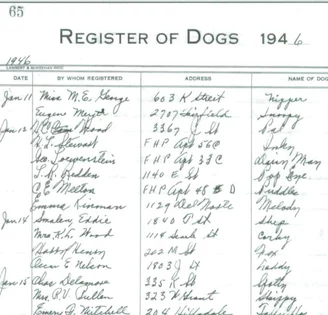
This page from the 1946 Registry of Dogs, a large leather-bound ledger on file at the Historical Society, indicates some of the popular pet names of the era. The Snoopy on line two is not a namesake of the famous quadruped, who did not appear until 1950. Click to enlarge.
We were allowed a fifteen-minute break every morning and afternoon, and an hour for lunch. Our lunchroom was a narrow back room that ran the width of the main room and had one tall window. This storage room contained a coffee pot, some chairs, our lunches and snacks, as well as shelves of office supplies reaching to the ceiling, accessed by a ladder running on an overhead track. Beulah and I brought bits of embroidery to work on while we sat by the light of the tall, narrow window and talked during our fifteen- minute breaks.
The summer of 1953 was my last summer as Miss Dog Tag. The following winter, the 1954 earthquake bit just after twelve oclock noon on December 21. Most of the staff had gone to lunch, but Beulah was standing at the counter with Fred Moore. Sam Merryman, a county supervisor, was leaving the office and had gotten as far as the door that had a glass transom over it. As Sam stood in the doorway, Beulah expected the glass to fall out of the transom onto him. She tried to move around the counter, to warn him, but with each step the floor came up to her foot, so she just hung on to the counter. Luckily, the glass transom did not fall. Behind Beulah, the metal file drawers full of heavy files were moving in and out. Above her head, suspended by bars, the fluorescent ceiling lights swayed crazily, scattering plaster over everything. She expected the lights to fall on her, but they stayed suspended, hanging in a lopsided fashion. Beulah, a young newlywed, feared that she was going down in a heap of rubble and that her husband, Tom, would never know what had happened to her.
That earthquake proved that the building was unsafe. It would have been very costly, and maybe impossible, to shore it up to meet new earthquake codes. It was a shame to have to tear down the old court house after seventy years (its cornerstone was laid on July 4, 1884), even though it was altogether too small for the needs of Humboldt County in the mid-twentieth century. The County Clerk’s office had to be temporarily moved to the Veterans Memorial Building. Later, many of the records were transferred to the Recorder’s office. The Post Office now takes passport applications, and the County Agricultural Department handles dog licenses and animal control. (The city of Eureka has its own dog license department.)
I will always have fond memories of the three summers when I “reigned” as Miss Dog Tag of Humboldt County. To have been able to work in the historical Victorian courthouse with the dedicated people of the County Clerk’s office was a special time for me. In addition, I found a lifetime friend in Beulah Wahlund. Although we have not been able to stay in close contact, for I moved away from Humboldt County, we have kept in touch through Christmas cards all this time—fifty-seven years. I could not have written this account of working at the old court house selling dog licenses without her help.
Do we know who had the longest name of any dog in Humboldt County? Not definitively, but we think the honor may belong to the dog shown below, St. Patrick Bartholomew Diaz Garibaldi Strong. Paddy, as he was called, is held by a friend, Clarence Lord, on February 8, 1899.
###
The story above is from the Winter 2008 issue of the Humboldt Historian, a journal of the Humboldt County Historical Society. It is reprinted here with permission. The Humboldt County Historical Society is a nonprofit organization devoted to archiving, preserving and sharing Humboldt County’s rich history. You can become a member and receive a year’s worth of new issues of The Humboldt Historian at this link.
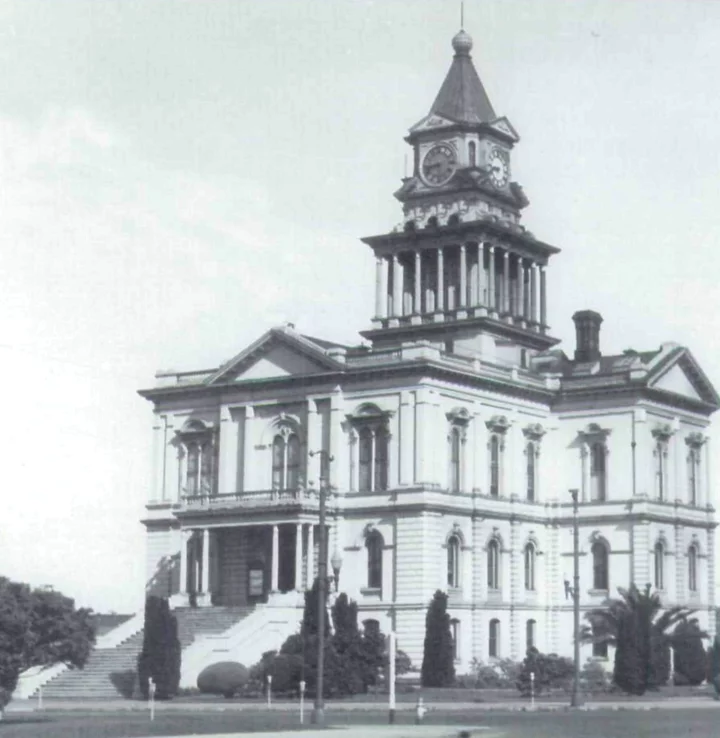
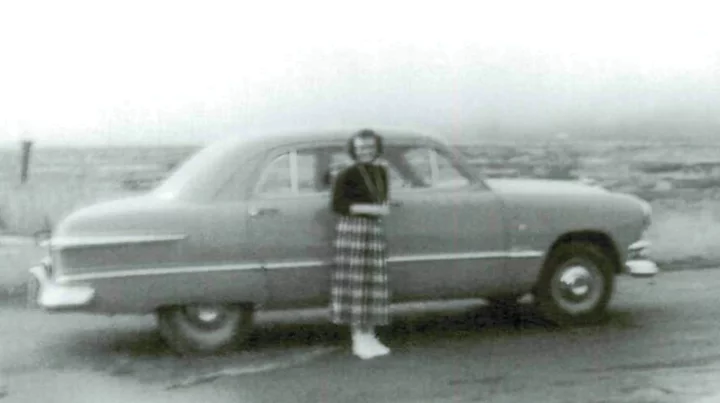
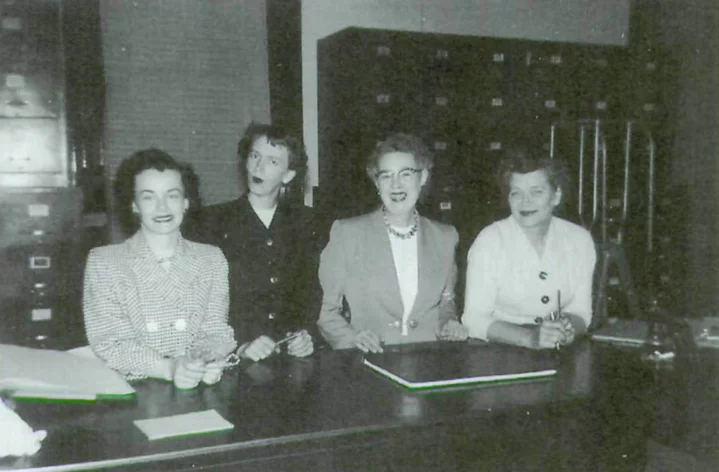
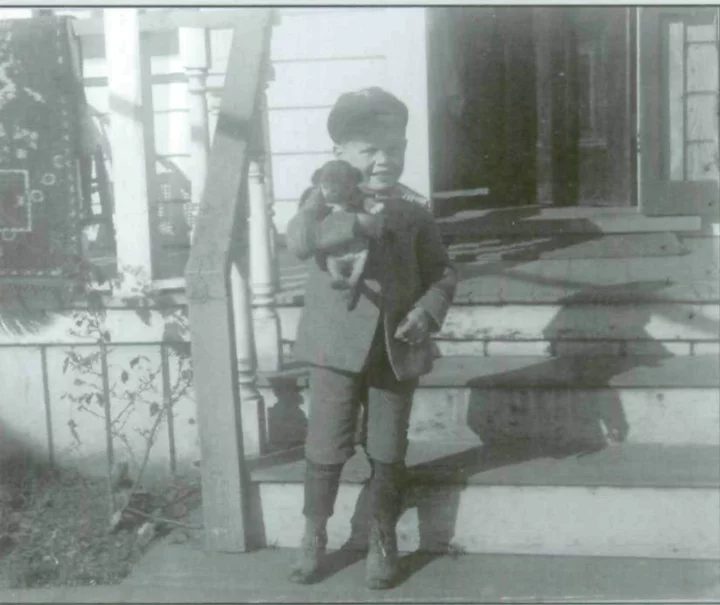
CLICK TO MANAGE